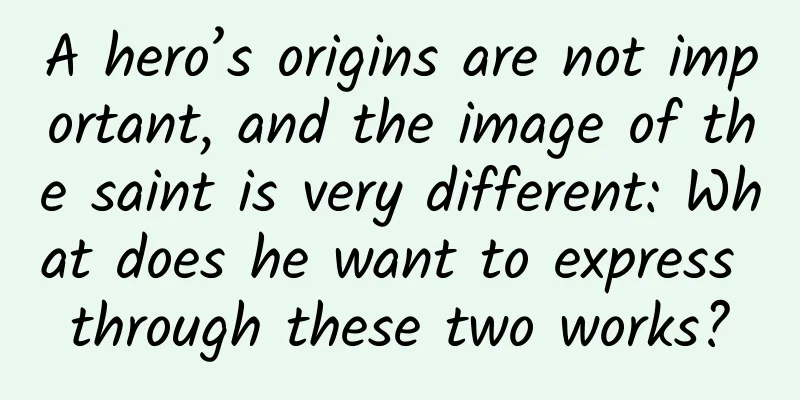A hero’s origins are not important, and the image of the saint is very different: What does he want to express through these two works?

|
Donatello, who invented the layered carving technique, created many important works throughout his life. Among them, there are two works we cannot miss: one is a bronze equestrian statue, which quickly became a new landmark of the city after its completion; the other is his most famous work in his later years. The image of the saint he created is very different from other works of art. Written by | Zhang Yi 1 Bronze equestrian statue of Gattamirata in Padua Padua undoubtedly has a special charm for Italians in the Renaissance. According to the great Roman poet Virgil in his epic poem Aeneid, Padua was founded in 1183 BC by Antenor, a Trojan general and hero in Homer's epic; the famous Roman historian Livy also recorded the same in his Ab Urbe Condita, and the latter was born in Padua. After the Middle Ages, one of the earliest universities in the world was established in this city; and Petrarch (real name Francesco Petrarca, 1304-1374), a great humanist scholar and poet laureate in Florence in the early Renaissance, settled in the city in his later years and taught and wrote at the University of Padua until his death. The bronze equestrian statue "The Equestrian Statue of Gattamelata" completed by Donatello in 1453 quickly became a new landmark of the city (Figure 1). This 340-centimeter-high sculpture restored a tradition that had been lost for more than a thousand years and was an important milestone in the history of the Renaissance in terms of art and technology. Figure 1. Donatello, bronze equestrian statue "Gattamilata", completed in 1453, 340 cm high, now located in Padua, Italy | Image source: Wikipedia The rider of the bronze statue is the mercenary leader Erasmo da Narni (1370-1443), known as Gattamelata (meaning "spotted cat"). The sculptor vividly portrayed the horse's restlessness and the bravery of the rider. This mercenary leader spent most of his life in the service of the Republic of Venice, and was promoted to the commander-in-chief of the armed forces of the Republic of Venice because of his outstanding achievements. According to Vasari in his biography, after his death in 1443, the Venetian Senate planned to make a bronze equestrian statue for him to honor his loyal service to the Republic, so they invited Donatello, who was already the most famous sculptor in Italy at the time, to come to his hometown of Padua to make a bronze equestrian statue for him. This was the first time that Europeans had used bronze equestrian statues of ancient Roman emperors after the long dark ages of the Middle Ages. Its successful production also set a precedent for later generations to commemorate and honor military leaders, war heroes, and imperial emperors. When making this statue, Donatello drew on two bronze equestrian statues left over from ancient Rome. But unlike the statue of the ancient Roman Emperor Marcus Aurelius (121-180 AD) that we can still see in Rome today, Donatello paid more attention to using the facial expressions, body postures and various decorations to show Gattamirata's achievements, status and influence. He praised the leadership qualities of this Renaissance Venetian statesman on horseback in a very realistic way. The serious expression on the face of the mercenary captain who was gazing into the distance showed his strong character. At the same time, this should also be the humanistic brilliance and the spirit of pursuing individual human dignity reflected by many Italian city-state leaders of that era (Figure 1a). Gattamirata died in his seventies, but Donatello chose to depict the knight in his prime, at the height of his powers, for his sculpture. Figure 1a. Donatello, bronze equestrian statue "Gattamirata" (partial) | Image source: Wikipedia Donatello made extensive use of symbolic techniques to express the achievements of the mercenary captain. We see that he holds a scepter and wears a long sword. At the same time, under the left front hoof of his mount is a round object symbolizing the earth. It is through these symbols that the sculptor seems to tell people that Gattamirata's success and conquest are not only in Italy, but in the whole world. We should realize that the shape of the horse stepping on the sphere is not only a symbolic technique, but also an important technical treatment method. The sphere connected to the horse's hoof actually plays an important supporting role in the sculpture. Donatello obviously borrowed the treatment of horses from the bronze knight sculpture of the ancient Roman Sun King, which had not been destroyed at that time. Donatello completed the horse part of the sculpture in a completely realistic way, which is completely different from the equestrian statues made in the Middle Ages after the classical era. The sculptor's accurate description of the horse's muscles and movements shows the Renaissance artists' deep understanding and skilled application of anatomy. Beyond the technical level, the demeanor of the horse sculpted by Donatello echoes the alert and heroic demeanor of Gattamirata, further expressing the protagonist's fearless leadership spirit and temperament through the sculpture of the horse. Donatello's success in casting bronze equestrian statues undoubtedly marked that after the long and dark Middle Ages, people in Italy, the birthplace of modern European civilization, once again restored and mastered the ancient Roman bronze casting technology, which made possible a series of subsequent sculpture art creations. In fact, until the 19th century, the progress of bronze equestrian statues was a perfect combination of artistic exploration and scientific technology in different eras in the West. Although the patron of the bronze equestrian statue was Erasmus da Narni's family, placing it in the square of the famous Basilica Pontificia di Sant'Antonio di Padova required the official approval of the Republic of Venice (Figure 1b). At that time, the Republic of Venice was facing the pressure of military expansion from the Ottoman Empire in the East, so using a bronze equestrian statue to honor the contribution of the mercenary leader Erasmus da Narni to the Republic had a strong symbolic significance. During the Renaissance, Italy saw the emergence of a group of powerful mercenary captains, but there were very few who were willing to give up some of their personal ambitions and loyally serve a particular country for a long time. Another one was Bartolomeo Colleoni (1420-1475), who later also left a bronze equestrian statue in Venice. It was precisely because of their choice that they eventually went down in history with the special glory of the bronze equestrian statues of ancient Roman emperors. Figure 1b. The Basilica of St. Anthony in Padua and the bronze equestrian statue "Gattamilata" next to it | Image source: Wikipedia It is also worth pointing out that during the Renaissance in Italy in the 15th and 16th centuries, people began to gradually break the hierarchical concepts handed down from the European Middle Ages. Although traditional aristocratic families still had a huge influence, people of common origin, such as these mercenary leaders, as long as they were capable, would not only be recognized for their achievements, but could even become heroes and be glorious for all eternity. It can be said that a hero does not care about his or her origin. 2 The Penitent Magdalene The polychrome painted wood sculpture Penitent Magdalene was created by Donatello between 1453 and 1455 (Fig. 2). It was placed in the Florence Baptistery for a long time during the Renaissance and later. It is probably Donatello's most famous work from his later years, when he returned to Florence from Padua, when he was in his sixties. Figure 2. Donatello, The Penitent Magdalene, painted and gilded wood carving, made between 1453 and 1455, 188 cm high, now on display in the Florence Cathedral Museum | Image source: Wikipedia Mary Magdelene is a Christian saint. She was a promiscuous woman when she was young. After meeting Jesus, she completely gave up her previous life, which was considered completely sinful in traditional Christian morality. She eventually went into the desert for many years, praying sincerely for a long time, begging God to forgive her sins. The unusually thin body of Magdalene tells us about her long years of fasting and abstinence in the desert, and of course, it also allows the viewer to feel the sculptor's mastery of human structure and anatomy. We read more than just pious sorrow, pious repentance and desire for salvation from Magdalene's face. Standing in front of the statue, it is difficult for people to fully understand her extremely complex inner world. The wood carving we see in the museum today is basically brown, but recent conservation and restoration work has revealed that Magdalene's long hair was originally made of gold foil. I find it hard to imagine what it looked like in the baptistery in the past. Perhaps this golden light that penetrates the darkness will allow believers to feel her holy power of salvation through repentance. Her deep-set eyes reveal a firm and clear gaze, and her look seems to have transcended everything in the world, which makes people have to sigh at her tenacity and perseverance due to her faith. People familiar with Italian Renaissance art will easily notice that the image of Magdalene created by Donatello is very different from the image of Magdalene in popular Italian artworks, which usually portray Magdalene as a young, beautiful, even glamorous and sexy woman, the most famous of which is the work of the same name painted by Titian (Figure 2a). Some Western art historians believe that Donatello may have been inspired by the image of the Eastern Orthodox icon "Saint Mary of Egypt" (c. 344-421), and I tend to believe this. Figure 2a. Titian, The Penitent Magdalene, oil on canvas, 1560s, 119 cm high, 97 cm wide, now on display at the Hermitage Museum in St. Petersburg, Russia | Photo courtesy of Mr. Mikhail Guryev If we compare the statue of the same name made by Donatello's student and follower Desiderio da Settignano (Figure 2b), although the two are similar, the emotional message conveyed to the viewer by the image created by the latter is much simpler than that of Donatello's work. Although this contemporary work has certain similarities with Donatello's work in terms of surface modeling, it should be closer in spirit to the sculpture or painting of the Western European Catholic tradition. If Donatello tried to explore the inner spiritual world of individual human beings through his works, Setignano's works are obviously more decorative. The sculptor hopes to express a kind of abstract or universal Christian spirit of salvation through confession. If we carefully observe and study another work made by Donatello's student at the same time, the marble bust of Marietta Strozzi (Figure 3), we will notice that she should be the most beautiful woman in the aristocratic circle of Florence at that time. However, the beauty expressed in this sculpture is almost abstract. The sculptor shows more of the commonality of female beauty, just like Venus in Botticelli's paintings. This tendency to express the common beauty of human beings should foreshadow the arrival of the Neoplatonic art form of Florentine sculpture and painting. Figure 2b. Disetrio da Setignano, Magdalene, polychrome wood carving, made between 1453 and 1455, now on display in Santa Trinita, Florence | Image source: Wikipedia Figure 3. Setignano, Marietta Strozzi, marble bust, 1460, height 53 cm, Staatliche Museen, Berlin, Germany | Image source: Wikipedia About the Author Zhang Yi is an art historian, consultant to the Clock and Ancient Musical Instruments Department of the Hermitage Museum in Russia, consultant to the French Pendulum Clock Gallery, consultant to the Guangdong Clock Collection Research Professional Committee, and also a mathematician and logician. Special Tips 1. Go to the "Featured Column" at the bottom of the menu of the "Fanpu" WeChat public account to read a series of popular science articles on different topics. 2. Fanpu has opened the function of searching articles by month. Follow the official account and reply with the four-digit year + month, such as "1903", to get the article index of March 2019, and so on. Copyright statement: Personal forwarding is welcome. Any form of media or organization is not allowed to reprint or excerpt without authorization. For reprint authorization, please contact the backstage of the "Fanpu" WeChat public account. |
Recommend
How much does it cost to be an agent for a tea mini program in Puyang?
How much does it cost to be a Puyang agent for th...
Case Analysis | How to achieve “unity of knowledge and action” when writing a promotion plan?
Today we are going to talk about writing a planni...
Install Linux terminal emulation and environment app for Android
Today I recommend a Linux terminal emulation and ...
What can become popular on Tik Tok?
1. Grasp the best time for hot events Friends who...
Why does Chang'e-5 adopt a "relay" method for sample return?
By December 2021, the Chang'e-5 sample return...
Simple meditation for 5 minutes a day for 7 days can help you enter deep sleep
Please reply in the comment section to get the co...
Who is being cheated by the Windows 10 forced upgrade?
As early as when Windows 10 was released, Microsof...
The more you lack something, the more you want to show for it. Why is this so?
In life, we often encounter such people. We all k...
Behind the "price increase" of domestic smartphones, has the "low-price era" really passed?
At the beginning of the new year, domestic smartp...
Get these six points, attracting seed users will not be a problem
After everyone has experienced the first three ti...
Android devices more reliable than iPhones, report shows
Perhaps many consumers think that iPhones are mor...
The experience of APP promotion gained after spending a lot of promotion fees
I believe that many students who are responsible ...
Were there ever two suns in the sky?
Speaking of the sun, we all know since we were li...
About Git's Undo Command: How to Undo Everything in Git
One of the most useful features of any version co...









